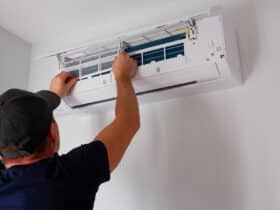Why Exterior Lighting Matters
Outdoor lighting is essential for improving your home’s appearance, security, and practicality. It highlights the architectural features of your property and provides a sense of security and comfort. Proper exterior lighting can transform outdoor spaces into inviting areas while deterring unwanted intrusions. When done right, exterior lighting can be both a practical necessity and a stylish enhancement. It’s not just about illuminating your house but creating an ambiance that elevates your property’s overall look and feel. Imagine coming home to a beautifully lit pathway or enjoying an evening barbecue in a well-lit backyard – the difference is undeniable.
Types of Exterior Lighting
Different kinds of outdoor lighting choices can be found in stores, each fulfilling a specific function and contributing a distinct visual aspect to your outdoor area. Popular choices include:
- Pathway Lights: Ideal for illuminating walkways and paths, these lights are usually low-mounted and guide you safely. They also add a charming glow to your garden pathways.
- Spotlights highlight specific features, such as trees, statues, and architectural details. Directing light to key features creates dramatic effects and adds depth to the landscape.
- Wall-Mounted Lights: These are affixed to your home’s exterior walls, providing security and style. They can be used to light up entryways or garage doors, making your home more welcoming and secure.
- Post Lights: Installed on top of posts, these lights are perfect for driveways and garden paths. They provide broad illumination and can be decorative, enhancing your property’s character.
Benefits of Proper Exterior Lighting
Proper exterior lighting offers numerous benefits that go beyond mere illumination:
- Enhanced Aesthetics: Strategically placed lights can accentuate the beauty of your home’s exterior. Exterior lighting boosts your property’s aesthetics by highlighting architectural elements and landscaping.
- Improved Safety: Well-lit paths and driveways reduce the risk of trips and falls. It is essential for families with young children or elderly members who may need better visibility at night.
- Security: Bright lighting can deter potential intruders from targeting your home. Sufficient lighting near entrances and shadowy areas can also reduce your property’s appeal to intruders.
Tips for Designing Your Exterior Lighting
Designing your exterior lighting can be a fun and creative process. Here are some tips to consider:
- Start with a plan. Map out the areas you want to light up, considering both functional and aesthetic considerations.
- Combine different lighting types for a layered effect. Mix path lights, spotlights, and wall-mounted fixtures to create depth and interest.
- Use warm-colored lights to create a welcoming atmosphere. Warm tones are more inviting and can make your outdoor space feel cozy.
- Invest in timers and motion sensors for added convenience and security. These features ensure your lights are on when needed and can help conserve energy.
Energy-Efficient Lighting Options
The increasing popularity of LED lights is attributed to their extended lifespan and reduced energy usage, making them a cost-efficient choice for lighting. These lights help reduce energy bills and have a lower environmental impact.
Safety Considerations
While exterior lighting improves safety, installing lights properly to avoid hazards is essential. Ensure that all outdoor fixtures are rated for exterior use and are weather-resistant. It prevents issues related to water exposure and extreme temperatures.
Avoid overloading circuits and use ground fault circuit interrupters (GFCIs) to prevent electrical shocks. Additionally, regular inspection and maintenance of your exterior lighting can prevent potential fire hazards and prolong the life of your lighting system.
Installation Tips
When installing exterior lighting, follow these steps:
- Choose the right fixtures for your needs and aesthetic preferences. Consider the style, color temperature, and brightness level of the lights.
- Plan the wiring layout, considering both functionality and safety. Ensure that wires are hidden or protected and that there’s easy access for maintenance.
- Consult an electrician if you need clarification on the electrical aspects. Professional help can ensure that the installation meets safety codes and regulations.
- Install lights at the correct heights to ensure optimal illumination. Pathway lights should be low to the ground, while spotlights may need to be higher for adequate coverage.
- Evaluate the lighting system to ensure it meets your needs. Walk around your property at night to observe how the lights function and make adjustments as needed.
Maintaining Your Exterior Lighting
Regular maintenance of your exterior lighting keeps it functioning efficiently. Clean the fixtures and replace bulbs as needed. Over time, particle build-up and dirt can gather, diminishing the lights’ efficiency. Check for any exposed wiring or damage caused by weather elements. Periodic professional inspections can help identify and fix potential issues before they become significant problems. Remember to adjust the positions of the lights seasonally, if needed, to account for changes in daylight and the appearance of your landscape.















